Coleman Collection
The Coleman Collection is now housed at the Guelph Youth Music Centre.
The musical instruments that comprise the Coleman Collection represent one collector's passion for the music and musical instruments of different cultures around the world. Barbara Coleman collected most of them over a period of several decades; some were found while she was traveling abroad, and others were found in local antique shops in the Baden area. In order to allow the instruments to be displayed so that students and scholars could study them, she offered the collection on permanent loan to the University of Guelph. They were first housed in the Rare Book Room of the MacLaughin Library, but because of space limitations, they were moved in 1984 to a more visible and convenient location in the MacKinnon Building. With the assistance of Dr. Edward R. Phillips, who was Chair of the Department of Music, and Dr. David Murray, who was Dean of the College of Arts, a permanent exhibit was installed in room 108 MacKinnon. Several faculty members also contributed to the installation, including Bruce French (instructor of guitar) and Dr. James Hunt (Professor of Physics).
The Instruments
Some of the instruments in the Coleman Collection are of a type still used today in classical, popular, and folk music ensembles, whereas others are unusual examples or handmade, one-of-a-kind folk instruments. The unifying theme of the Coleman Collection of Musical Instruments is that they represent the type of instruments that were used by immigrants who settled in Canada, and who could have either brought them here from their homeland or acquired them here. A few of the instruments were manufactured in Canada and are therefore historical documents for the study of musical instrument building in this country. Together, they demonstrate the rich and diverse musical heritage that contributed to 19th- and 20th'-century Canadian culture.
This page contains photographs and a historical sketch of each instrument. Research, photography, and the writing of individual entries took place during the Fall semester, 1997 and was accomplished by Darren Long, Joan Faehrmann, Holly Sharpe and Jennifer Luxmore, as a group project for 67-420 Directed Readings in Music. We offer this catalogue as a summary of our present state of knowledge about this extraordinary collection of musical instruments.
Comments and inquiries are welcome and should be sent to:
Brenda Gibson
Guelph Youth Music Centre
75 Cardigan Street
Guelph, ON
N1H 3Z7
(519) 837-1119
email: info@gymc.ca
website: www.gymc.ca
Image gallery
African Flutes
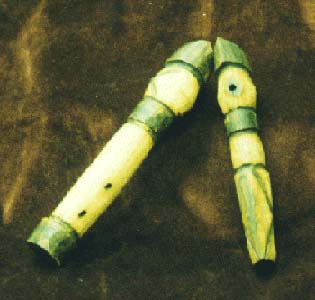 Flutes are very widespread in Africa and well integrated into African musical culture. Flutes belong to the family called aerophones, or wind instruments. They are made from a variety of materials, including wood, bamboo, cane husks, tips of horn gourds, clay, stalks of millet, metal, and fruit casings. Along with this variety of materials comes a variety of shapes. Oval and round shaped flutes are usually made from clay and fruit casings. More predominantly, there are transverse and vertical flutes. The vertical flutes may have notched or rounded mouthpieces, and may be open ended or stopped. The number of holes also varies, but generally there are no more than 6 holes. The flutes with very little holes can increase their range of tones, and are to be played in conjunction with other flutes which have a different specified range. Together they play in ensembles and can compliment each other, each flute playing its own melody, together creating an intense interlocking pattern. Flutes are very versatile; not only can they play in flute ensembles, but they can also play solo pieces (either improvised or composed), duets, or trios. 'They can play the melody when played in ensembles made up of drums, lyres, and raftles, and flutes are also used as a part of African culture to convey signals.
Flutes are very widespread in Africa and well integrated into African musical culture. Flutes belong to the family called aerophones, or wind instruments. They are made from a variety of materials, including wood, bamboo, cane husks, tips of horn gourds, clay, stalks of millet, metal, and fruit casings. Along with this variety of materials comes a variety of shapes. Oval and round shaped flutes are usually made from clay and fruit casings. More predominantly, there are transverse and vertical flutes. The vertical flutes may have notched or rounded mouthpieces, and may be open ended or stopped. The number of holes also varies, but generally there are no more than 6 holes. The flutes with very little holes can increase their range of tones, and are to be played in conjunction with other flutes which have a different specified range. Together they play in ensembles and can compliment each other, each flute playing its own melody, together creating an intense interlocking pattern. Flutes are very versatile; not only can they play in flute ensembles, but they can also play solo pieces (either improvised or composed), duets, or trios. 'They can play the melody when played in ensembles made up of drums, lyres, and raftles, and flutes are also used as a part of African culture to convey signals.
African Spike Lute
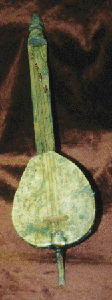 The specific name and country of origin of this particular instrument are not known. It is likely an African instrument. The lute is found in many African societies in both bowed and plucked varieties. Of the bowed varieties the most widespread is the one-string fiddle. Plucked lutes come in one-string varieties and also in varieties with two to five strings. There was no bow accompanying this instrument (although it may have been lost). The configuration of the four strings, however, suggests that it is a plucked lute.
The specific name and country of origin of this particular instrument are not known. It is likely an African instrument. The lute is found in many African societies in both bowed and plucked varieties. Of the bowed varieties the most widespread is the one-string fiddle. Plucked lutes come in one-string varieties and also in varieties with two to five strings. There was no bow accompanying this instrument (although it may have been lost). The configuration of the four strings, however, suggests that it is a plucked lute.
Anklung
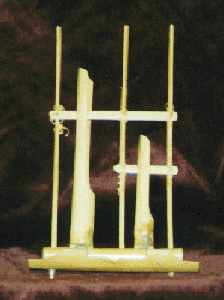 The anklung is a tuned bamboo sliding rattle of Indonesia. It is especially popular in West Java. The anklung is played by shaking the instrument sideways, setting the tubes swinging. The two prongs in the base of the instrument strike the ends of the slots with a clatter, accompanied by stopped-pipe notes from the air vibrating in the tubes. Traditionally, the anklung is played in groups of three of more, with each instrument being shaken sideways by one person in an interlocking, hocket-like manner, together with an oboe, drums, and gongs. This group is one type of gamelan and accompanies hobby-horse and other traditional dances. There are various other types of gamelan in Indonesia. The anklungs in a gamelan are tuned to give between them five note scales which makes up the base on which the other instruments build. In a gamelan which contains only anklungs, it is necessary to have as many players as there are tones in the scale of the tune. The tuning of the anklung has traditionally been based on scales which are common in Indonesia but in recent years it has been tuned diatonically as well. In recent years, anklungs have gained in popularity perhaps under the influence of Western music-education bands.
The anklung is a tuned bamboo sliding rattle of Indonesia. It is especially popular in West Java. The anklung is played by shaking the instrument sideways, setting the tubes swinging. The two prongs in the base of the instrument strike the ends of the slots with a clatter, accompanied by stopped-pipe notes from the air vibrating in the tubes. Traditionally, the anklung is played in groups of three of more, with each instrument being shaken sideways by one person in an interlocking, hocket-like manner, together with an oboe, drums, and gongs. This group is one type of gamelan and accompanies hobby-horse and other traditional dances. There are various other types of gamelan in Indonesia. The anklungs in a gamelan are tuned to give between them five note scales which makes up the base on which the other instruments build. In a gamelan which contains only anklungs, it is necessary to have as many players as there are tones in the scale of the tune. The tuning of the anklung has traditionally been based on scales which are common in Indonesia but in recent years it has been tuned diatonically as well. In recent years, anklungs have gained in popularity perhaps under the influence of Western music-education bands.
Balalaika
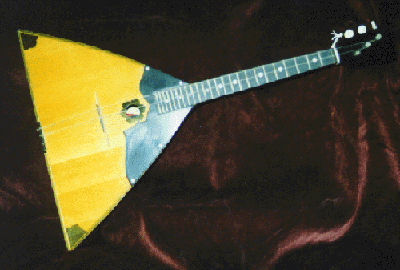 The balalaika is a member of a large and varied family of Central Asian lutes. The balalaika is one of the most popular and best known folk instruments in Eastern Europe, and the quintessential lute in Russia and the Ukraine. This long-necked lute replaced the dombra in the 18th century possibly because its triangular body shape was more suitable for hand-made mass production. There are six different sizes of balalaikas, each with three strings of gut or steel. The example in the Coleman Collection is a very common one known as the prima balalaika. The balalaika is played with the fingers using a wide variety of techniques. It is strung with one metal A and two nylon E strings. The metal string is used as the drone which is accompanied by the melody played on the two remaining strings. An interesting feature of this instrument is the offset second string which is closer to the third string rather than the first, facilitating the use of the left hand thumb, a significant part of the playing technique. The balalaika is typically strummed with the forefinger but the strings are also plucked individually. The tuning of the balalaika varies according to the region and the genre of music. The balalaika sound has often been described as "Tinkling". A single balalaika often accompanies song and dance, but large ensembles are also common. A very intricate, virtuosic repertoire has elevated the balalaika to the level of a classical instrument, and balalaika orchestras have toured all over the world.
The balalaika is a member of a large and varied family of Central Asian lutes. The balalaika is one of the most popular and best known folk instruments in Eastern Europe, and the quintessential lute in Russia and the Ukraine. This long-necked lute replaced the dombra in the 18th century possibly because its triangular body shape was more suitable for hand-made mass production. There are six different sizes of balalaikas, each with three strings of gut or steel. The example in the Coleman Collection is a very common one known as the prima balalaika. The balalaika is played with the fingers using a wide variety of techniques. It is strung with one metal A and two nylon E strings. The metal string is used as the drone which is accompanied by the melody played on the two remaining strings. An interesting feature of this instrument is the offset second string which is closer to the third string rather than the first, facilitating the use of the left hand thumb, a significant part of the playing technique. The balalaika is typically strummed with the forefinger but the strings are also plucked individually. The tuning of the balalaika varies according to the region and the genre of music. The balalaika sound has often been described as "Tinkling". A single balalaika often accompanies song and dance, but large ensembles are also common. A very intricate, virtuosic repertoire has elevated the balalaika to the level of a classical instrument, and balalaika orchestras have toured all over the world.
Castanets
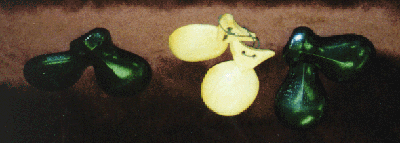 The castanets, which belong to the percussion family, are sounded by clicking two similar wooden parts together. They are thought to have been ancient Egyptian instruments made of wood. Although there was no record of the castanets until the 16th century, they were depicted in art work as far back as the 13th century. In ancient Egypt the castanets were shaped like a small boot or like the very modern Spanish ones. They were also known in ancient Greece and are mentioned many times in -Greco-Roman literature as krotalon, or krembalon, both meaning a dancer's instrument. Castanets remained in use in Spain throughout the Middle Ages and became known as the national instrument. Although relatively popular, they never became really well known much beyond southern Italy. The pair in the Coleman Collection is of the modern style and shape. They can be made from a variety of woods such as grenadilla, chestnut, box, or walnut. Both historically and today, castanets are played in two pairs. The player holds each pair in his or her hand passing the joining cord between the thumb and one finger. The dancers who use them both today and in the past have clicked them rhythmically or sounded long and short rolls. There are also sister versions of the castanets that are used in band music in Spain. They have long stems attached to each of the pairs. This type is also used for rhythm.
The castanets, which belong to the percussion family, are sounded by clicking two similar wooden parts together. They are thought to have been ancient Egyptian instruments made of wood. Although there was no record of the castanets until the 16th century, they were depicted in art work as far back as the 13th century. In ancient Egypt the castanets were shaped like a small boot or like the very modern Spanish ones. They were also known in ancient Greece and are mentioned many times in -Greco-Roman literature as krotalon, or krembalon, both meaning a dancer's instrument. Castanets remained in use in Spain throughout the Middle Ages and became known as the national instrument. Although relatively popular, they never became really well known much beyond southern Italy. The pair in the Coleman Collection is of the modern style and shape. They can be made from a variety of woods such as grenadilla, chestnut, box, or walnut. Both historically and today, castanets are played in two pairs. The player holds each pair in his or her hand passing the joining cord between the thumb and one finger. The dancers who use them both today and in the past have clicked them rhythmically or sounded long and short rolls. There are also sister versions of the castanets that are used in band music in Spain. They have long stems attached to each of the pairs. This type is also used for rhythm.
Cheng
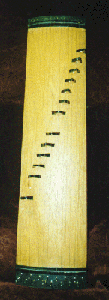 The zither family is indigenous to China. The cheng was developed during the Ch'in dynasty (897BC-221BC) in western China. The instrument has a treble tonal range. The strings are usually tuned to three pentatonic octaves. Each string has its own adjustable bridge which divides the string into two sections. Higher pitches are produced by depressing the string with the left hand on the left side of the bridge, thereby increasing the tension in the string. The left hand must use considerable pressure to produce stopped tones and is therefore not free to move quickly. The left hand is also used for ornamentation techniques. The right hand plucks the strings with the fingernails or individual finger picks on the right side of the bridge. The cheng has always been used for entertainment. During the first part of the period from 206 BC to AD 581, it was used in a common street music ensemble of voice, wind, and string instruments. Later in that period it was part of another vocal, wind, and string ensemble that performed popular folk songs. In the period after AD 581 the pipa became an important member of ensembles providing music at court banquets. Although still an ensemble member at court banquets in the Ming and Ch'ing dynasties (1 368-1 91 1 ), it decreased in prominence. The cheng is still used in some ensembles, most notably the hsung-shih (poetic strings), but since the mid-19th century, its use as a solo instrument has overtaken its ensemble functions. With the shift in emphasis to solo performance, the technique and repertory of the cheng have grown in complexity.
The zither family is indigenous to China. The cheng was developed during the Ch'in dynasty (897BC-221BC) in western China. The instrument has a treble tonal range. The strings are usually tuned to three pentatonic octaves. Each string has its own adjustable bridge which divides the string into two sections. Higher pitches are produced by depressing the string with the left hand on the left side of the bridge, thereby increasing the tension in the string. The left hand must use considerable pressure to produce stopped tones and is therefore not free to move quickly. The left hand is also used for ornamentation techniques. The right hand plucks the strings with the fingernails or individual finger picks on the right side of the bridge. The cheng has always been used for entertainment. During the first part of the period from 206 BC to AD 581, it was used in a common street music ensemble of voice, wind, and string instruments. Later in that period it was part of another vocal, wind, and string ensemble that performed popular folk songs. In the period after AD 581 the pipa became an important member of ensembles providing music at court banquets. Although still an ensemble member at court banquets in the Ming and Ch'ing dynasties (1 368-1 91 1 ), it decreased in prominence. The cheng is still used in some ensembles, most notably the hsung-shih (poetic strings), but since the mid-19th century, its use as a solo instrument has overtaken its ensemble functions. With the shift in emphasis to solo performance, the technique and repertory of the cheng have grown in complexity.
Ching-Hu
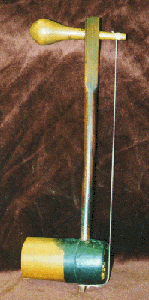 The ching-hu is one of five types of Chinese bowed lutes (see also erh-hu) known as hu-ch'in or spike fiddles. Spike fiddles are distinguished by a tubular, hexagonal, or octagonal resonating chamber pierced by a long, slender neck which protrudes from the lower side. Like all hu-ch'in, the ching-hu is played in a vertical position with the bridge facing towards the right to bring the bow to the correct angle. The player partly depresses the strings with the fingers of the left hand to produce stopped tones, but the strings do not touch the neck. The bow is held in the players right hand resting on the index finger with the thumb on top. Although some modern hu-ch'in bows have a nut to tighten the bow hairs, most players must use the ring finger of the bow-hand to hold the bow hair taut. A unique feature of Chinese spike fiddles is that the bow hair passes between the two strings. The hair must be unhitched to remove the bow. The exact origin of the ching-hu is not known. It was found originally in the north of China, possibly as late as the 1811 or 1911 centuries. The name means 'Beijing fiddle' (ching: the capital city of Beijung and hu: originally 'barbarian' now 'fiddle'). It became immensely popular through its use in the Peking opera, a type of musical theater that has dominated the Chinese national stage since the 19th century. The orchestra is divided into two ensembles; a melodic ensemble including the erh-hu, and a percussion ensemble. The ching-hu plays a leading role in the ensemble as the most important melody instrument and as an accompanying instrument, ornamenting and elaborating the male vocal lines. Its high-pitched, bright, nasal tone is considered ideal for this role.
The ching-hu is one of five types of Chinese bowed lutes (see also erh-hu) known as hu-ch'in or spike fiddles. Spike fiddles are distinguished by a tubular, hexagonal, or octagonal resonating chamber pierced by a long, slender neck which protrudes from the lower side. Like all hu-ch'in, the ching-hu is played in a vertical position with the bridge facing towards the right to bring the bow to the correct angle. The player partly depresses the strings with the fingers of the left hand to produce stopped tones, but the strings do not touch the neck. The bow is held in the players right hand resting on the index finger with the thumb on top. Although some modern hu-ch'in bows have a nut to tighten the bow hairs, most players must use the ring finger of the bow-hand to hold the bow hair taut. A unique feature of Chinese spike fiddles is that the bow hair passes between the two strings. The hair must be unhitched to remove the bow. The exact origin of the ching-hu is not known. It was found originally in the north of China, possibly as late as the 1811 or 1911 centuries. The name means 'Beijing fiddle' (ching: the capital city of Beijung and hu: originally 'barbarian' now 'fiddle'). It became immensely popular through its use in the Peking opera, a type of musical theater that has dominated the Chinese national stage since the 19th century. The orchestra is divided into two ensembles; a melodic ensemble including the erh-hu, and a percussion ensemble. The ching-hu plays a leading role in the ensemble as the most important melody instrument and as an accompanying instrument, ornamenting and elaborating the male vocal lines. Its high-pitched, bright, nasal tone is considered ideal for this role.
Concertina
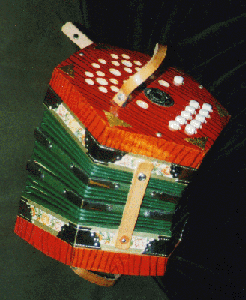 The German Konzertina was invented by C. F. Uhlig (1769-1874) in 1834. It was square in shape, diatonic, and had 'single action' buttons that produced different pitches when the bellows were pressed and drawn. In 1829 the British physicist, Sir Charles Wheatstone (1802-1875), invented a free-reed mouth organ which he called a symphonium. Later he added bellows to the symphonium, which eventually led to the development of an instrument which he called a concertina-named after the German instrument. The instrument was hexagonal in shape, fully chromatic, and had 'double action' buttons that produced the same pitch on extension and compression of the bellows. Virtuosi such as Giulio Regondi (1822-1872) and Richard Balgrave (1826-95) recognized the musical possibilities of the powerful and expressive tone of the English concertina. Their skill on the new instrument helped to spread its fame. It became widely popular in Europe, North America, and South America. Original works for the concertina were composed, including two concertos by Regondi, and chamber music. Charles Ives and Percy Grainger are among some 20th-century composers to include the concertina in their compositions. With the rise of the larger accordion at the beginning of the twentieth century, the concertina's popularity waned, but it retained its popularity in the music hall and in folk music. The Anglo-German concertina in particular is still popular among English folk musicians. Its exact origins are not known, but it is thought to have been introduced as an improved version of the original German type, possibly by an English fine instrument maker by the name of Jeffries. Standard forms now have thirty or more buttons.
The German Konzertina was invented by C. F. Uhlig (1769-1874) in 1834. It was square in shape, diatonic, and had 'single action' buttons that produced different pitches when the bellows were pressed and drawn. In 1829 the British physicist, Sir Charles Wheatstone (1802-1875), invented a free-reed mouth organ which he called a symphonium. Later he added bellows to the symphonium, which eventually led to the development of an instrument which he called a concertina-named after the German instrument. The instrument was hexagonal in shape, fully chromatic, and had 'double action' buttons that produced the same pitch on extension and compression of the bellows. Virtuosi such as Giulio Regondi (1822-1872) and Richard Balgrave (1826-95) recognized the musical possibilities of the powerful and expressive tone of the English concertina. Their skill on the new instrument helped to spread its fame. It became widely popular in Europe, North America, and South America. Original works for the concertina were composed, including two concertos by Regondi, and chamber music. Charles Ives and Percy Grainger are among some 20th-century composers to include the concertina in their compositions. With the rise of the larger accordion at the beginning of the twentieth century, the concertina's popularity waned, but it retained its popularity in the music hall and in folk music. The Anglo-German concertina in particular is still popular among English folk musicians. Its exact origins are not known, but it is thought to have been introduced as an improved version of the original German type, possibly by an English fine instrument maker by the name of Jeffries. Standard forms now have thirty or more buttons.
Dahu
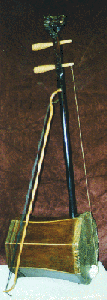 The dahu is a large erhu, one of five types of Chinese two-string, bowed lute or hu-ch'in (see also ching-hu). Er means 'two' and hu originally meant 'barbarian' but now means 'fiddle'. The erhu is similar to the ching-hu but larger. Unlike the ching-hu, whose body and neck are made of bamboo, the body and neck of the erhu are mainly constructed of hardwood. The body is usually hexagonal or octagonal but may also be round. Like the ching-hu, one end of the resonator has a snakeskin covering, but on the erhu, the other end is usually decorated with an open-work design. The top of the neck of an erhu is often carved in a stylized dragon or bat form. It is held and played in a manner similar to that of the ching-hu In the 18th and 19th centuries the erhu was a well known instrument in the Peking opera and was used to accompany narrative folk songs. Its origins prior to that time are uncertain. The erhu was popularized in the 1920s by the violinist Liu Tianhua, who was trained in both Western and Chinese music. Although it is still used in traditional Chinese instrumental and theatre ensembles, it has achieved greater importance as an ensemble instrument in the modem Chinese orchestra and as a solo instrument in the recital hall. During the 1930s larger sizes of erhu were designed for the new orchestral uses. They correspond approximately to viola, cello, and double bass. The zhonghu ('middle hu') has an alto range and is tuned a 4th or 5th below an erhu. The dahu ('large hu') has a tenor range and is tuned an octave below the erhu. The dihu ('bass hu') has a bass range and is tuned an octave below the dahu.
The dahu is a large erhu, one of five types of Chinese two-string, bowed lute or hu-ch'in (see also ching-hu). Er means 'two' and hu originally meant 'barbarian' but now means 'fiddle'. The erhu is similar to the ching-hu but larger. Unlike the ching-hu, whose body and neck are made of bamboo, the body and neck of the erhu are mainly constructed of hardwood. The body is usually hexagonal or octagonal but may also be round. Like the ching-hu, one end of the resonator has a snakeskin covering, but on the erhu, the other end is usually decorated with an open-work design. The top of the neck of an erhu is often carved in a stylized dragon or bat form. It is held and played in a manner similar to that of the ching-hu In the 18th and 19th centuries the erhu was a well known instrument in the Peking opera and was used to accompany narrative folk songs. Its origins prior to that time are uncertain. The erhu was popularized in the 1920s by the violinist Liu Tianhua, who was trained in both Western and Chinese music. Although it is still used in traditional Chinese instrumental and theatre ensembles, it has achieved greater importance as an ensemble instrument in the modem Chinese orchestra and as a solo instrument in the recital hall. During the 1930s larger sizes of erhu were designed for the new orchestral uses. They correspond approximately to viola, cello, and double bass. The zhonghu ('middle hu') has an alto range and is tuned a 4th or 5th below an erhu. The dahu ('large hu') has a tenor range and is tuned an octave below the erhu. The dihu ('bass hu') has a bass range and is tuned an octave below the dahu.
Double Bell
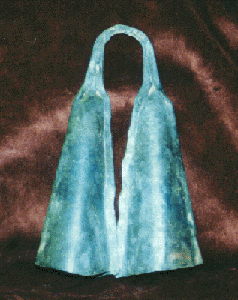 The double bell is a part of the African percussion family. The first known double bell was thought to have come into existence during the Nigerian Benin period of the 16th century. It was first made of carved ivory and usually crafted by locals. Since its beginning it has been used solely as a folk instrument in accompanying ritual and other forms of celebration. It has two internal chambers producing different pitches and resembles a double cowbell in both sound and size. Today the double bell is sometimes referred to as the struck bells or double cowbell and is made from different metals. It is struck using a metal or wooden beater in a rhythmic manner and can be used in many percussive variations. It is found in local craft and antique stores as well as music stores around the world and can still be heard in African folk music and throughout the world as one of the most unique yet simplistic percussion instruments.
The double bell is a part of the African percussion family. The first known double bell was thought to have come into existence during the Nigerian Benin period of the 16th century. It was first made of carved ivory and usually crafted by locals. Since its beginning it has been used solely as a folk instrument in accompanying ritual and other forms of celebration. It has two internal chambers producing different pitches and resembles a double cowbell in both sound and size. Today the double bell is sometimes referred to as the struck bells or double cowbell and is made from different metals. It is struck using a metal or wooden beater in a rhythmic manner and can be used in many percussive variations. It is found in local craft and antique stores as well as music stores around the world and can still be heard in African folk music and throughout the world as one of the most unique yet simplistic percussion instruments.
Dulcimer
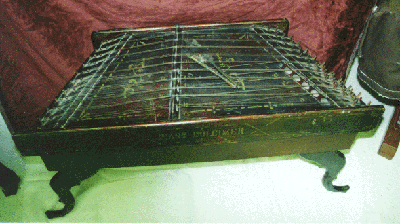 The dulcimer is a box zither that is played with hammers. The box is most often in the shape of a trapezoid and is always played in a horizontal position. The strings are made of piano wire, are unfretted, and are usually divided into two segments by a bridge. The strings must be thin to sound properly but, as one thin string would be insufficient to vibrate the soundboard effectively, there are two to six strings per course. There is a ringing quality to the dulcimer because the strings are usually undamped. Sometimes the side of the hand may be used to damp the strings, and the large concert cimbalon (as the dulcimer is known in Eastern Europe) has a damper pedal. A tremolo technique with the hammers is used to sustain long notes. The dulcimer was thought to have originated in Persia in the 10th century but there is evidence to the contrary. Its history before the mid-15th century is uncertain. By the mid-15th century the dulcimer was known in most of Europe, and by 1800 it had reached the Far East and was widespread throughout Europe and North America. It was popular with fashionable European audiences throughout the 17th and 18th centuries and was also a popular domestic instrument. Some very fine instruments have been preserved from the 17th century and onwards, in particular those made by the Battaglia family. The dulcimer was always popular in country areas, and continued to be popular as a folk instrument in the 19th century, even though in cultivated Western society it was gradually replaced by the piano
The dulcimer is a box zither that is played with hammers. The box is most often in the shape of a trapezoid and is always played in a horizontal position. The strings are made of piano wire, are unfretted, and are usually divided into two segments by a bridge. The strings must be thin to sound properly but, as one thin string would be insufficient to vibrate the soundboard effectively, there are two to six strings per course. There is a ringing quality to the dulcimer because the strings are usually undamped. Sometimes the side of the hand may be used to damp the strings, and the large concert cimbalon (as the dulcimer is known in Eastern Europe) has a damper pedal. A tremolo technique with the hammers is used to sustain long notes. The dulcimer was thought to have originated in Persia in the 10th century but there is evidence to the contrary. Its history before the mid-15th century is uncertain. By the mid-15th century the dulcimer was known in most of Europe, and by 1800 it had reached the Far East and was widespread throughout Europe and North America. It was popular with fashionable European audiences throughout the 17th and 18th centuries and was also a popular domestic instrument. Some very fine instruments have been preserved from the 17th century and onwards, in particular those made by the Battaglia family. The dulcimer was always popular in country areas, and continued to be popular as a folk instrument in the 19th century, even though in cultivated Western society it was gradually replaced by the piano
Finger Cymbals
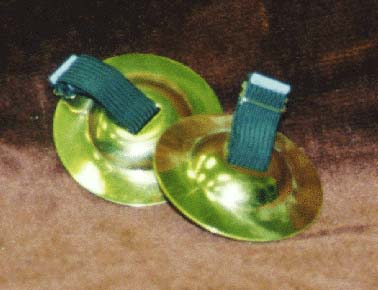 The finger cymbals are a traditional percussion instrument of Indonesia. They have been known since antiquity and are still used today. These small cymbals are played in pairs with one on the thumb and the other on the middle or index finger. The fundamental note is g4, the top g on the piano. Today the finger cymbals are primarily used by dancers in the Islamic world and Indonesia.
The finger cymbals are a traditional percussion instrument of Indonesia. They have been known since antiquity and are still used today. These small cymbals are played in pairs with one on the thumb and the other on the middle or index finger. The fundamental note is g4, the top g on the piano. Today the finger cymbals are primarily used by dancers in the Islamic world and Indonesia.
Garklein Recorder
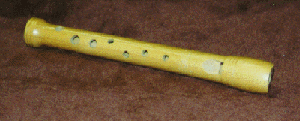 The recorder is a versatile instrument that is in widespread use today. It belongs to the whistle flute family and is a woodwind instrument. The very first recorder is dated between the late 14th or early 16th centuries. They are used as solo instruments, in duets and trios, and in a variety of ensembles, and occasionally even in orchestras. Generally, a recorder is made from a variety of woods, such as boxwood, tropical hardwoods, pear, and maple. Elaborate recorders were known to be made of ivory and today even plastic has been used, especially for inexpensive models. The recorder has a whistle-like mouthpiece called the fipple. Sound is produced when air is blown through the mouthpiece in a steady stream. Different notes are produced depending on the holes that are covered up by the players fingers and thumb. The thumb hole is used to help create the octave. Renaissance recorders are assembled in one entire piece, baroque recorders are constructed as either one complete piece or in three moveable parts, and today's recorders are composed of three moveable parts. The renaissance recorder generally has a range of an octave and a 6th above. The principal role of renaissance recorders was as part of an ensemble (called a consort) and it was rarely used as a solo instrument. The Garklein's range is from c3 -f4. It is higher in pitch than the sopranino. Garklein recorders have few holes and are generally used as octave instruments in modern day ensembles
The recorder is a versatile instrument that is in widespread use today. It belongs to the whistle flute family and is a woodwind instrument. The very first recorder is dated between the late 14th or early 16th centuries. They are used as solo instruments, in duets and trios, and in a variety of ensembles, and occasionally even in orchestras. Generally, a recorder is made from a variety of woods, such as boxwood, tropical hardwoods, pear, and maple. Elaborate recorders were known to be made of ivory and today even plastic has been used, especially for inexpensive models. The recorder has a whistle-like mouthpiece called the fipple. Sound is produced when air is blown through the mouthpiece in a steady stream. Different notes are produced depending on the holes that are covered up by the players fingers and thumb. The thumb hole is used to help create the octave. Renaissance recorders are assembled in one entire piece, baroque recorders are constructed as either one complete piece or in three moveable parts, and today's recorders are composed of three moveable parts. The renaissance recorder generally has a range of an octave and a 6th above. The principal role of renaissance recorders was as part of an ensemble (called a consort) and it was rarely used as a solo instrument. The Garklein's range is from c3 -f4. It is higher in pitch than the sopranino. Garklein recorders have few holes and are generally used as octave instruments in modern day ensembles
Guitar Zither
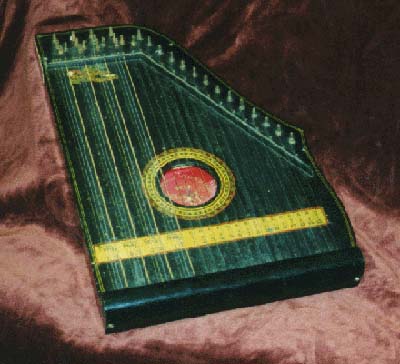 The guitar zither is a part of the chordophone family. It is shaped much like an ordinary zither and includes 31 strings. The guitar zither has its roots in the German tradition of zither crafting, thought to have emerged during the second half of the 19th century. Many manufacturers are still making such zithers today and they can frequently be found accompanying vocalists in folk music of many countries. A fretless instrument, the guitar zither is played with the left and right hand, with it placed either in a players lap or on a table. The guitar zither also has two sections of strings, one used as melody, or voice strings, and the other as accompaniment. The melody section is made up of 15 strings in total and these strings are tuned to, from lowest to highest, c, d, e, f, g, a, b, cl, d1, el, f1, g1, a1, bl, c2. The accompaniment strings are set in four groups of four and these groups are tuned in various ways. They are used to support the needs of the vocalist or player and, when sounded, may appear to be quite like the sound of a harp or harpsichord.
The guitar zither is a part of the chordophone family. It is shaped much like an ordinary zither and includes 31 strings. The guitar zither has its roots in the German tradition of zither crafting, thought to have emerged during the second half of the 19th century. Many manufacturers are still making such zithers today and they can frequently be found accompanying vocalists in folk music of many countries. A fretless instrument, the guitar zither is played with the left and right hand, with it placed either in a players lap or on a table. The guitar zither also has two sections of strings, one used as melody, or voice strings, and the other as accompaniment. The melody section is made up of 15 strings in total and these strings are tuned to, from lowest to highest, c, d, e, f, g, a, b, cl, d1, el, f1, g1, a1, bl, c2. The accompaniment strings are set in four groups of four and these groups are tuned in various ways. They are used to support the needs of the vocalist or player and, when sounded, may appear to be quite like the sound of a harp or harpsichord.
Half-tube Zither
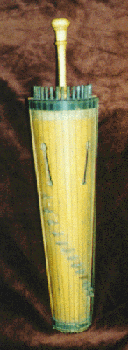 The specific name and country of origin of this instrument are not known. The tube or half-tube zither is a relatively primitive form of zither found mainly in Asia but also in Africa, southeastern Europe, and the Americas. This particular instrument however, was made in 1887 and probably in an English-speaking country (the words on the back are in English.)
The specific name and country of origin of this instrument are not known. The tube or half-tube zither is a relatively primitive form of zither found mainly in Asia but also in Africa, southeastern Europe, and the Americas. This particular instrument however, was made in 1887 and probably in an English-speaking country (the words on the back are in English.)
Harmonium
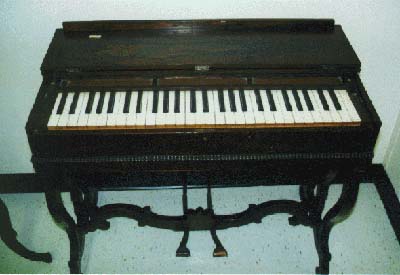 Harmonium was the name given by Alexandre Francois Debain to the reed organ he patented in 1840. Many similar instruments were patented by others under different names, but eventually the name harmonium was used throughout Europe and England to refer to all reed organs that used compression bellows. Reed organs using suction bellows, such as the one in the Coleman Collection, were more commonly called American organs. In the early 19th century, free-reed instruments recognizable as reed organs began to appear independently in Germany, the U. S. A., England, and France. European instrument makers pursued the expressive possibilities of the instrument, and the harmonium came to be highly respected by serious composers and musicians. American builders, following an independent course, made reed organs of simpler construction and less musical sophistication. In America, reed organs were mass-produced in large factories. Because of their simple construction, low cost, and ability to stay in tune, American organs exceeded the piano in domestic use for over half a century. Reed organs were usually the first instruments in small churches and were used in the Sunday schools and chapels of larger churches. Missionaries took them abroad, introducing them to Japan and India. When mass-production lowered the cost and increased the availability of the piano at the beginning of the 20th century, interest in the American organ waned. By mid-century electronic instruments had taken over the market, and production of the reed organ ceased. The harmonium is still used in some Indian music and is still manufactured in India and Pakistan.
Harmonium was the name given by Alexandre Francois Debain to the reed organ he patented in 1840. Many similar instruments were patented by others under different names, but eventually the name harmonium was used throughout Europe and England to refer to all reed organs that used compression bellows. Reed organs using suction bellows, such as the one in the Coleman Collection, were more commonly called American organs. In the early 19th century, free-reed instruments recognizable as reed organs began to appear independently in Germany, the U. S. A., England, and France. European instrument makers pursued the expressive possibilities of the instrument, and the harmonium came to be highly respected by serious composers and musicians. American builders, following an independent course, made reed organs of simpler construction and less musical sophistication. In America, reed organs were mass-produced in large factories. Because of their simple construction, low cost, and ability to stay in tune, American organs exceeded the piano in domestic use for over half a century. Reed organs were usually the first instruments in small churches and were used in the Sunday schools and chapels of larger churches. Missionaries took them abroad, introducing them to Japan and India. When mass-production lowered the cost and increased the availability of the piano at the beginning of the 20th century, interest in the American organ waned. By mid-century electronic instruments had taken over the market, and production of the reed organ ceased. The harmonium is still used in some Indian music and is still manufactured in India and Pakistan.
Harp Lute
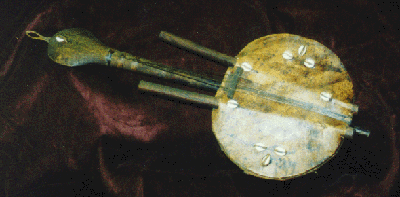 The harp lute has from 6 to 21 strings. The number of strings varies from region to region. It is played and has an important role in certain African ceremonies such as weddings, in religious practices, and in child naming ceremonies. The strings are attached in pairs to leather tuning straps which are tightened or loosened to achieve the desired pitch. It is played with both hands, with similar techniques to the harp. The thumb plucks the strings away, and the fore fingers are used to pluck the strings toward the player. The rest of the fingers grip the two hand posts. Generally, both hands alternate playing the harp, with each hand playing a different pattern. The most impressive harp lute is the kora of the Mande people of Africa. It is a 21 string lute which is played mainly to accompany the voice. It is played by Jalolu, professional musicians and historians of the Mande people, who pass on history and culture through voice and song. They are very talented kora musicians highly skilled at telling and retaining stories. Typically kora pieces consist of four parts. (i) the donikilo ( the general vocal melody), (ii) the sataro (the improvised vocal part), (iii) the kumbengo (a short repeating instrumental part), and (iv) the birimintingo (the improvised instrumental part.)
The harp lute has from 6 to 21 strings. The number of strings varies from region to region. It is played and has an important role in certain African ceremonies such as weddings, in religious practices, and in child naming ceremonies. The strings are attached in pairs to leather tuning straps which are tightened or loosened to achieve the desired pitch. It is played with both hands, with similar techniques to the harp. The thumb plucks the strings away, and the fore fingers are used to pluck the strings toward the player. The rest of the fingers grip the two hand posts. Generally, both hands alternate playing the harp, with each hand playing a different pattern. The most impressive harp lute is the kora of the Mande people of Africa. It is a 21 string lute which is played mainly to accompany the voice. It is played by Jalolu, professional musicians and historians of the Mande people, who pass on history and culture through voice and song. They are very talented kora musicians highly skilled at telling and retaining stories. Typically kora pieces consist of four parts. (i) the donikilo ( the general vocal melody), (ii) the sataro (the improvised vocal part), (iii) the kumbengo (a short repeating instrumental part), and (iv) the birimintingo (the improvised instrumental part.)
Hurdy Gurdy
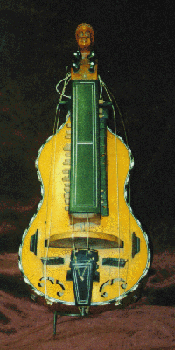 The hurdy-gurdy is thought to have come into existence during the 12th century. It was considered a wheel fiddle whose gut strings were sounded by turning a wheel mounted inside the body and placed on an axle. Between the 12th to 14th centuries the wooden keys on the instrument came in various arrangements. These keys, as today, were used to stop the strings. The keys themselves were mounted in a variety of positions according to the personal preferences of the builder or the individual player. During the 15th century the hurdy-gurdy began to take on the role of a folk instrument and the keys were mounted in a keybox fixed on top of the body. It was much like today's hurdy-gurdy with a smaller neck than its predecessor from the 12th century. Once it became primarily a folk instrument, it started to grow in popularity among the street musicians in many European countries, such as France (Vielle), Germany (Leier), and England (Cymbal). In France however, it was introduced back into the higher classes, during the reign of Louis XIV, often making up part of his court ensembles. The hurdy-gurdy in the Coleman Collection is of French descent. French instrument makers now include versions of the hurdy-gurdy in lute and guitar forms. Although the use of the hurdy-gurdy declined after the 18th century, it is still being made in France and other countries by local craftsmen for use in folk music. The modern hurdy-gurdy is carried on a sling with the keys played by the left hand, while the right turns the crank. There are usually three or four strings, with two or three strings serving as drones. The hurdy-gurdy in this collection has a typical human figure as a head, and a string formation of two melody strings inside the box and two drone strings outside the box.
The hurdy-gurdy is thought to have come into existence during the 12th century. It was considered a wheel fiddle whose gut strings were sounded by turning a wheel mounted inside the body and placed on an axle. Between the 12th to 14th centuries the wooden keys on the instrument came in various arrangements. These keys, as today, were used to stop the strings. The keys themselves were mounted in a variety of positions according to the personal preferences of the builder or the individual player. During the 15th century the hurdy-gurdy began to take on the role of a folk instrument and the keys were mounted in a keybox fixed on top of the body. It was much like today's hurdy-gurdy with a smaller neck than its predecessor from the 12th century. Once it became primarily a folk instrument, it started to grow in popularity among the street musicians in many European countries, such as France (Vielle), Germany (Leier), and England (Cymbal). In France however, it was introduced back into the higher classes, during the reign of Louis XIV, often making up part of his court ensembles. The hurdy-gurdy in the Coleman Collection is of French descent. French instrument makers now include versions of the hurdy-gurdy in lute and guitar forms. Although the use of the hurdy-gurdy declined after the 18th century, it is still being made in France and other countries by local craftsmen for use in folk music. The modern hurdy-gurdy is carried on a sling with the keys played by the left hand, while the right turns the crank. There are usually three or four strings, with two or three strings serving as drones. The hurdy-gurdy in this collection has a typical human figure as a head, and a string formation of two melody strings inside the box and two drone strings outside the box.
Klonton
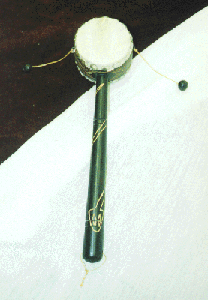 The klonton is a rattle drum with external percussion. Percussion is by impact of the wax balls. Rattle drums with internal percussion have pebbles inside of the drum. In both cases the drum is shaken to produce percussion. Rattle drums with external percussion are found chiefly in Asia, Arabia, and Egypt. They originated in ancient China. The klonton is a miniature version of the modern Chinese rattle drum. It is used by the Chinese population of Java and Bali primarily to accompany dancing and by street vendors.
The klonton is a rattle drum with external percussion. Percussion is by impact of the wax balls. Rattle drums with internal percussion have pebbles inside of the drum. In both cases the drum is shaken to produce percussion. Rattle drums with external percussion are found chiefly in Asia, Arabia, and Egypt. They originated in ancient China. The klonton is a miniature version of the modern Chinese rattle drum. It is used by the Chinese population of Java and Bali primarily to accompany dancing and by street vendors.
Lute
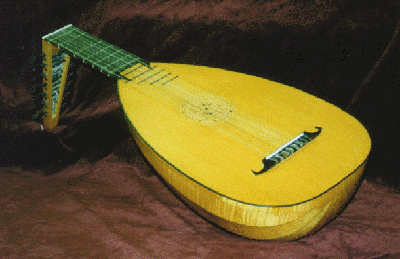 The lute is a European instrument which peaked in popularity in the 16th and 17th centuries. It evolved from the ud which was introduced into Europe by the Moors around 711A.D. Europeans added frets, and eventually it was double strung (in pairs of strings) and became known as the lute. By the beginning of the 13th century there are pictures and sculptures of Europeans playing the lute. The very early lutes had backs carved from a solid piece of wood, but by the Renaissance a series of separate strips of wood were used to construct the curved back. By the 15th century a standard tuning of the lute was established. At first the lute was played with a plectrum like the ud, but as the music became more complex it was played with the fingers. The instrument is plucked and when playing, the right little finger is always held against the soundboard. The lute is the first instrument for which a large quantity of written music can be found. There are volumes of tutorial works concerning the playing technique as well. From the later Middle Ages to the mid-18th century the lute repertoire far exceeds that of any other instrument of the time, certainly in quantity, and possibly also in quality. During the Renaissance, the lute was very common but it also was a highly respected instrument of its time and therefore occupied a very special place of honour only surpassed by the human voice. After 1800, however, the lute was replaced by the guitar. Compared with the guitar, the lute has a characteristic sound of its own. It has a brighter tone, with more pronounced upper partials, but also a more nasal and less powerful timbre.
The lute is a European instrument which peaked in popularity in the 16th and 17th centuries. It evolved from the ud which was introduced into Europe by the Moors around 711A.D. Europeans added frets, and eventually it was double strung (in pairs of strings) and became known as the lute. By the beginning of the 13th century there are pictures and sculptures of Europeans playing the lute. The very early lutes had backs carved from a solid piece of wood, but by the Renaissance a series of separate strips of wood were used to construct the curved back. By the 15th century a standard tuning of the lute was established. At first the lute was played with a plectrum like the ud, but as the music became more complex it was played with the fingers. The instrument is plucked and when playing, the right little finger is always held against the soundboard. The lute is the first instrument for which a large quantity of written music can be found. There are volumes of tutorial works concerning the playing technique as well. From the later Middle Ages to the mid-18th century the lute repertoire far exceeds that of any other instrument of the time, certainly in quantity, and possibly also in quality. During the Renaissance, the lute was very common but it also was a highly respected instrument of its time and therefore occupied a very special place of honour only surpassed by the human voice. After 1800, however, the lute was replaced by the guitar. Compared with the guitar, the lute has a characteristic sound of its own. It has a brighter tone, with more pronounced upper partials, but also a more nasal and less powerful timbre.
Mandolin
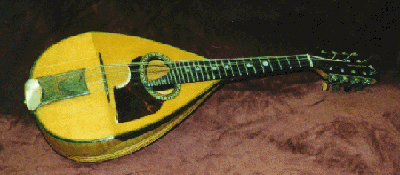 The early Neapolitan mandolin dates back to 1735. It was a very popular instrument in Naples in all classes of society and was used mainly for instrumental pieces, or as accompaniment to voice in the opera. Some distinguishing features of this instrument were its elaborate decoration with materials such as mother of pearl, tortoise shell, wood, ebony, and ivory. The rounded back of the mandolin instead of the traditional flat back was apparently the choice of Neapolitan mandolin makers in order to create a better sound in the lower register. The round back of the Neapolitan mandolin is very distinctive, since the two hbs adjacent to the soundboard are of greater depth than the rest of the ribs. One of the most famous families of Neapolitan mandolin makers was the Vinaccia family. The early instrument was plucked with a quill plectrum. The modern Neapolitan mandolin was created in the 1830's. Several adaptations were made on the earlier instrumental design. They included lengthening and raising the fingerboard, increasing the size of the instrument, making it more decorative, and using steel and copper strings. The plectrum came to be made of tortoise shell, as the strength of the wires was too much for the quill plectrum. Often tremolo is used when playing the mandolin. This technique of rapid back and forth picking was used to create the impression of notes. The Neapolitan mandolin was used in Paisiello's, barbiere di Sivigilia, the serenade in Mozart's Don Giovanni, and Beethoven's early sonatinas for mandolin and piano. The Neapolitan mandolin decreased in popularity in the late 1911 century. At present, the most common uses of the mandolin are in Mediterranean folk music and in American blue grass.
The early Neapolitan mandolin dates back to 1735. It was a very popular instrument in Naples in all classes of society and was used mainly for instrumental pieces, or as accompaniment to voice in the opera. Some distinguishing features of this instrument were its elaborate decoration with materials such as mother of pearl, tortoise shell, wood, ebony, and ivory. The rounded back of the mandolin instead of the traditional flat back was apparently the choice of Neapolitan mandolin makers in order to create a better sound in the lower register. The round back of the Neapolitan mandolin is very distinctive, since the two hbs adjacent to the soundboard are of greater depth than the rest of the ribs. One of the most famous families of Neapolitan mandolin makers was the Vinaccia family. The early instrument was plucked with a quill plectrum. The modern Neapolitan mandolin was created in the 1830's. Several adaptations were made on the earlier instrumental design. They included lengthening and raising the fingerboard, increasing the size of the instrument, making it more decorative, and using steel and copper strings. The plectrum came to be made of tortoise shell, as the strength of the wires was too much for the quill plectrum. Often tremolo is used when playing the mandolin. This technique of rapid back and forth picking was used to create the impression of notes. The Neapolitan mandolin was used in Paisiello's, barbiere di Sivigilia, the serenade in Mozart's Don Giovanni, and Beethoven's early sonatinas for mandolin and piano. The Neapolitan mandolin decreased in popularity in the late 1911 century. At present, the most common uses of the mandolin are in Mediterranean folk music and in American blue grass.
Mandolin Guitarophone
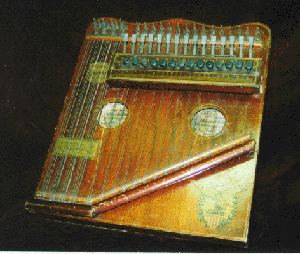 The mandolin guitarophone was a popular instrument in its time. It could be used by amateur musicians as a result of its simple, easy playing technique. It was used to accompany choral pieces and also to accompany other folk instruments. It has a range of two octaves and is double strung throughout. It is related to the autoharp, and it may even be an autoharp with a different name. The Canadian distributor was the Mandolin Guitarophone Company located on Jarvis Street In Toronto, and the manufacturer was probably located in Boston. Although relatively inconspicuous in music literature, the mandolin guitarophone was available in the fall of 1900 in the Sears Roebuck and Company consumer catalog and was listed as a mandolin harp, a three in one instrument with mandolin, guitar and zither components. In addition, the Dewelin model of the mandolin guitarophone, manufactured in 1915, can be viewed at the Wellington County Museum.
The mandolin guitarophone was a popular instrument in its time. It could be used by amateur musicians as a result of its simple, easy playing technique. It was used to accompany choral pieces and also to accompany other folk instruments. It has a range of two octaves and is double strung throughout. It is related to the autoharp, and it may even be an autoharp with a different name. The Canadian distributor was the Mandolin Guitarophone Company located on Jarvis Street In Toronto, and the manufacturer was probably located in Boston. Although relatively inconspicuous in music literature, the mandolin guitarophone was available in the fall of 1900 in the Sears Roebuck and Company consumer catalog and was listed as a mandolin harp, a three in one instrument with mandolin, guitar and zither components. In addition, the Dewelin model of the mandolin guitarophone, manufactured in 1915, can be viewed at the Wellington County Museum.
Mbira
Mbira is a general term for a family of instruments called lamellophones. Many mbiras have similar construction and components, but differ in cultural uses, in the number of keys, and in the name. The mbiras are constructed of specially shaped metal keys (size and shape dependent on pitch) which are usually mounted onto a wooden soundboard, and are placed inside a calabash gourd which is used as a resonator. Most mbiras have bottle caps attached to the resonator to create the typical 'buzzy' timbre of African music. They are played by depressing and releasing the keys, using the index fingers and the thumb. The right and the left thumb play downward, and the right index finger plays upward. The mbira is most commonly used in a group of two mbira players. One mbira plays the kushaura part which is the accompanying part. Typical of African music, each part plays its pattern creating an interlocking piece that sounds cyclic. Some believe that the mbira is a derivative of the xylophone, almost a portable xylophone due to its similar sound and the similar patterns they play. Perhaps the most documented mbira is the 22-keyed mbira dza vadzimu of the Shona people in Zimbabwe. It is used to call on the ancestral spirits in the bira (death) ceremony to ask for their guidance, advice, and support. It is seen by the Shona people as a very sacred instrument.
Nyckelharpa
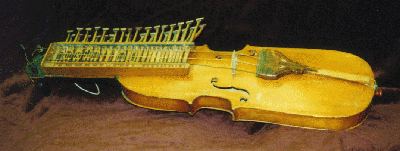 The nyckelharpa is a traditional Swedish instrument. In Swedish, "nyckel" means key and "harpa" refers to the guitar and fiddle. The nyckelharpa belongs to the same family as the French vielle and the English hurdy gurdy. The oldest evidence of this keyed fiddle is a picture from 1350 depicting two nyckelharpa players. There were two different types of nyckelharpas in the 16th and 17th centuries, one with a body in the shape of a figure eight and the other with either a pear or a boat shaped body. The boat shaped body became the norm in the late 17th century. The nyckelharpa later evolved to a shape that resembles the body of the violin, with a key-box attached to the top. Wooden keys slide under the strings and have tangents set perpendicularly to the keys. The melody strings are stopped by these keys to produce a particular note. The keys are pushed with the left hand held palm upwards. The strings are sounded together with a short bow, the hair tightened by the thumb of the right hand. The nyckelharpa sounds much like a fiddle but because of its larger body has much more resonance. It has been used for folk dance and festival music in Scandinavia for hundreds of years. The nyckelharpa now plays an important role in the folk music movement in Sweden, and many people study its construction and playing technique. At least four different versions of the nyckelharpa are still played today.
The nyckelharpa is a traditional Swedish instrument. In Swedish, "nyckel" means key and "harpa" refers to the guitar and fiddle. The nyckelharpa belongs to the same family as the French vielle and the English hurdy gurdy. The oldest evidence of this keyed fiddle is a picture from 1350 depicting two nyckelharpa players. There were two different types of nyckelharpas in the 16th and 17th centuries, one with a body in the shape of a figure eight and the other with either a pear or a boat shaped body. The boat shaped body became the norm in the late 17th century. The nyckelharpa later evolved to a shape that resembles the body of the violin, with a key-box attached to the top. Wooden keys slide under the strings and have tangents set perpendicularly to the keys. The melody strings are stopped by these keys to produce a particular note. The keys are pushed with the left hand held palm upwards. The strings are sounded together with a short bow, the hair tightened by the thumb of the right hand. The nyckelharpa sounds much like a fiddle but because of its larger body has much more resonance. It has been used for folk dance and festival music in Scandinavia for hundreds of years. The nyckelharpa now plays an important role in the folk music movement in Sweden, and many people study its construction and playing technique. At least four different versions of the nyckelharpa are still played today.
Pi'Pa
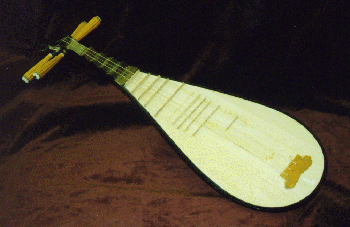 This lute of ancient and modem China is one of the most frequently played of the Chinese instruments. The pipa is held almost vertically, resting on the players lap, and is plucked with the fingernails of the right hand. Much of the music is played on the upper two strings with all five fingers plucking rapidly as the hand moves up and down the strings. The lower strings are plucked abruptly for dramatic effect. The left hand depresses the strings between the frets on the neck and upper portion of the belly. Pipa music tends to be programmatic, dealing with such subjects as human emotions and natural phenomena. The pipa is first mentioned in writings in the 2nd century A. D. The term p'i-p'a originally referred to two different right hand playing techniques: pi meant 'to play forward' and pa meant 'to play backward'. Differences between the early Chinese lutes were very slight and the same term, pipa, was used at first to describe several string instruments. The direct ancestor of the modem pipa, a short-necked lute with reversed pegbox, four strings, and four frets, likely came to China from Central Asia around the time of the Wei dynasty (AD 386-534). The number of frets gradually increased over the years. Now a pipa may have 16, 17, or 24 frets. The pipa achieved great popularity during the T'ang dynasty (AD 618-907) as a solo and ensemble instrument used for both popular and more refined types of entertainment. It was always the principal entertainment at court banquets. Today the pipa is played as a solo instrument and as an ensemble instrument in many regional opera orchestras, including the Peking opera, and in story-telling ensembles.
This lute of ancient and modem China is one of the most frequently played of the Chinese instruments. The pipa is held almost vertically, resting on the players lap, and is plucked with the fingernails of the right hand. Much of the music is played on the upper two strings with all five fingers plucking rapidly as the hand moves up and down the strings. The lower strings are plucked abruptly for dramatic effect. The left hand depresses the strings between the frets on the neck and upper portion of the belly. Pipa music tends to be programmatic, dealing with such subjects as human emotions and natural phenomena. The pipa is first mentioned in writings in the 2nd century A. D. The term p'i-p'a originally referred to two different right hand playing techniques: pi meant 'to play forward' and pa meant 'to play backward'. Differences between the early Chinese lutes were very slight and the same term, pipa, was used at first to describe several string instruments. The direct ancestor of the modem pipa, a short-necked lute with reversed pegbox, four strings, and four frets, likely came to China from Central Asia around the time of the Wei dynasty (AD 386-534). The number of frets gradually increased over the years. Now a pipa may have 16, 17, or 24 frets. The pipa achieved great popularity during the T'ang dynasty (AD 618-907) as a solo and ensemble instrument used for both popular and more refined types of entertainment. It was always the principal entertainment at court banquets. Today the pipa is played as a solo instrument and as an ensemble instrument in many regional opera orchestras, including the Peking opera, and in story-telling ensembles.
Rabab
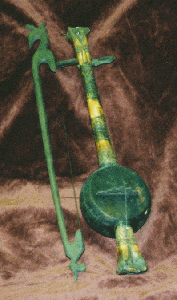 Found in 9th and 10th century texts, rabab is the oldest known Arabic word for a bowed instrument. The terms rebab, rubob, rebeb, rbeb and rbab are different dialect forms of the classical term rabab and are evidence of the extent of oral transmission of information in African and Indonesian cultures. Today these terms are used to describe a large number of instruments. The rabab was probably brought from Andalusia to North African cities with large numbers of Spaniards (Constantine in Algeria for example) and then spread to other places from there. The rabab is shown with the ud in late 19th century French engravings, and its was also played in cafes in Algiers. Rababs are played from North Africa across Asia to Indonesia. This rabab, in the Coleman Collection, originated from West Sumantra. The rabab is often the leader of a Javanese gamelan if it is of the loud type, meaning the gamelan has an majority of bronze instruments. In addition, the rabab is either played as a solo instrument or accompanies singing, especially of long epic poems. The two strings are tuned a fifth apart, fairly deep in the tenor range. The rabab player often sits cross-legged, with the rabab in front of him in an upright position. He bows with the right hand and tightens the hair of the bow with his fingers. The right hand stops the strings by finger pressure alone since there is no fingerboard. The sound produced by the rabab is said to resemble that of the human voice.
Found in 9th and 10th century texts, rabab is the oldest known Arabic word for a bowed instrument. The terms rebab, rubob, rebeb, rbeb and rbab are different dialect forms of the classical term rabab and are evidence of the extent of oral transmission of information in African and Indonesian cultures. Today these terms are used to describe a large number of instruments. The rabab was probably brought from Andalusia to North African cities with large numbers of Spaniards (Constantine in Algeria for example) and then spread to other places from there. The rabab is shown with the ud in late 19th century French engravings, and its was also played in cafes in Algiers. Rababs are played from North Africa across Asia to Indonesia. This rabab, in the Coleman Collection, originated from West Sumantra. The rabab is often the leader of a Javanese gamelan if it is of the loud type, meaning the gamelan has an majority of bronze instruments. In addition, the rabab is either played as a solo instrument or accompanies singing, especially of long epic poems. The two strings are tuned a fifth apart, fairly deep in the tenor range. The rabab player often sits cross-legged, with the rabab in front of him in an upright position. He bows with the right hand and tightens the hair of the bow with his fingers. The right hand stops the strings by finger pressure alone since there is no fingerboard. The sound produced by the rabab is said to resemble that of the human voice.
Sarinda
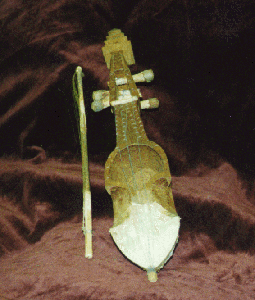 The sarinda is a major bowed instrument in South Asia and India. The sarinda in the Coleman Collection is from Nepal. The two central strings are tuned to the tonic with the top string a fifth higher and the bottom one a fourth lower. The sarinda is hand carved from a single piece of wood. Large indentations on the side of the sarinda accommodate for the movements of the bow as it changes from string to string. The sarinda is played only by men and is used to accompany singing. Today it is also used by street musicians as a solo instrument, to accompany themselves.
The sarinda is a major bowed instrument in South Asia and India. The sarinda in the Coleman Collection is from Nepal. The two central strings are tuned to the tonic with the top string a fifth higher and the bottom one a fourth lower. The sarinda is hand carved from a single piece of wood. Large indentations on the side of the sarinda accommodate for the movements of the bow as it changes from string to string. The sarinda is played only by men and is used to accompany singing. Today it is also used by street musicians as a solo instrument, to accompany themselves.
Sitar
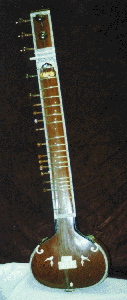 The sitar is from North India and is one of the most popular classical instruments of Hindustani music. Many claim Amir Khusru, a musician, poet and a statesman developed the sitar. Drawing on Persian musical elements, he derived the sitar from the Persian plucked lute and an Indian instrument called the veena. The sitar is played with a wire plectrum called the mizrab, which is placed on the right forefinger. The neck of the sitar is hollow and has 19 strings on it. Of the six main playing strings four are for melody, and two are for drone and rhythm. The eleven sympathetic strings underneath the frets vibrate when the main stings are plucked. The 19 curved metal frets are moveable to change the notes that are to be played in the different ragas. The sitar player sits in a crossed-legged position. The main gourd is placed on the sole of the left foot. The neck slants upwards and the right thumb presses firmly on the side to keep the right hand steady. The right hand uses up and down strokes across the strings. To create an embellishment, the wire on the furthest left is so flexible that when the left hand pulls it across the fret, four or five notes are heard. Traditionally, sitar playing is taught through the guru-student relationship. Sitar techniques are now more commonly taught through schools. Some of the most well-known sitarists of today are Ravi Shankar and Vilayat Khan
The sitar is from North India and is one of the most popular classical instruments of Hindustani music. Many claim Amir Khusru, a musician, poet and a statesman developed the sitar. Drawing on Persian musical elements, he derived the sitar from the Persian plucked lute and an Indian instrument called the veena. The sitar is played with a wire plectrum called the mizrab, which is placed on the right forefinger. The neck of the sitar is hollow and has 19 strings on it. Of the six main playing strings four are for melody, and two are for drone and rhythm. The eleven sympathetic strings underneath the frets vibrate when the main stings are plucked. The 19 curved metal frets are moveable to change the notes that are to be played in the different ragas. The sitar player sits in a crossed-legged position. The main gourd is placed on the sole of the left foot. The neck slants upwards and the right thumb presses firmly on the side to keep the right hand steady. The right hand uses up and down strokes across the strings. To create an embellishment, the wire on the furthest left is so flexible that when the left hand pulls it across the fret, four or five notes are heard. Traditionally, sitar playing is taught through the guru-student relationship. Sitar techniques are now more commonly taught through schools. Some of the most well-known sitarists of today are Ravi Shankar and Vilayat Khan
Zither
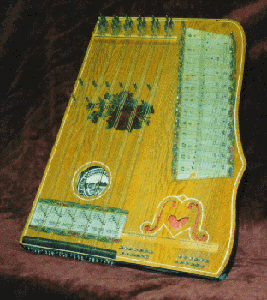 The zither is part of the chordophone family. Our modern zither has its roots in the Austrian and Bavarian tradition where zithers were used as folk instruments during the 17th century. It was a box zither then and was thought to have come from the Scheitholt found in Slovenia. Up to the 1830s the rectangular style of zither was still being made, but about this time two distinct schools of building started. One was at Miftenwald (the Miftenwaid Zither), while the other was at Salzburg (the Salzburg zither). Until the late 18th century the zither was found only in the Alpine regions, but as the Alps became more popular with travelers, the use of the zither became more widespread. This resulted in a significant increase of building activity and the zither began to be made in many different sizes for ensemble playing and in different types, such as the bowed zither. During the 1911 century, the zither began to take its standard form in Germany. It is now basically a rectangular box with a soundhole on the soundboard and two sets of strings, one for the melody and the other for accompaniment. The number of strings on a zither may vary, with some having as little as four and others as many as sixty. The one in the Coleman Collection has two sets of melody strings and these would generally be used to create a melody, with the rest of the strings being used as accompaniment. The steel melody strings are played with the player's right thumb and forefinger, using a ring plectrum. The left hand is simultaneously used for strumming preset chords. Several similar styles of zither can be found all over the world today.
The zither is part of the chordophone family. Our modern zither has its roots in the Austrian and Bavarian tradition where zithers were used as folk instruments during the 17th century. It was a box zither then and was thought to have come from the Scheitholt found in Slovenia. Up to the 1830s the rectangular style of zither was still being made, but about this time two distinct schools of building started. One was at Miftenwald (the Miftenwaid Zither), while the other was at Salzburg (the Salzburg zither). Until the late 18th century the zither was found only in the Alpine regions, but as the Alps became more popular with travelers, the use of the zither became more widespread. This resulted in a significant increase of building activity and the zither began to be made in many different sizes for ensemble playing and in different types, such as the bowed zither. During the 1911 century, the zither began to take its standard form in Germany. It is now basically a rectangular box with a soundhole on the soundboard and two sets of strings, one for the melody and the other for accompaniment. The number of strings on a zither may vary, with some having as little as four and others as many as sixty. The one in the Coleman Collection has two sets of melody strings and these would generally be used to create a melody, with the rest of the strings being used as accompaniment. The steel melody strings are played with the player's right thumb and forefinger, using a ring plectrum. The left hand is simultaneously used for strumming preset chords. Several similar styles of zither can be found all over the world today.